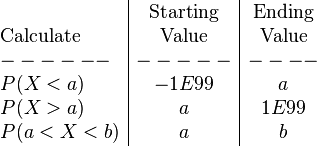
There are three styles for computing probability for a normal distribution are shown in the table.

Note: In a normal distribution, it doesn't matter if the question is < or ≤ .
The E is scientific notation and is found by pressing ![]()
![]()
The syntax of the command is:
normalcdf(starting value, ending value, mean, standard deviation)
Example: Let X be a continuous random variable with mean 50 and standard deviation 8.
Compute P(42 < X < 52).
Compute P( X > 52).